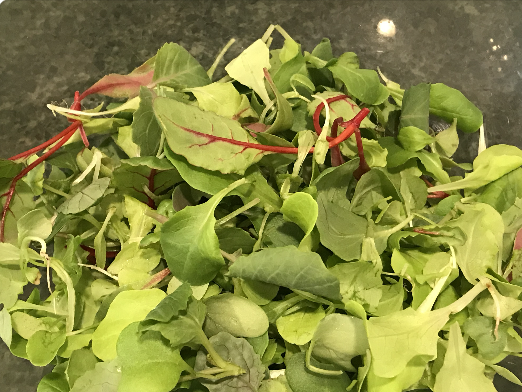We've all heard stories from the Great Depression and how many folks resorted to eating weeds like dandelions in salads and sautéed. Eating "weeds" goes back a lot longer than the 1930s, however. In Medieval Europe, dandelions and other wild greens were used for medicinal and culinary consumption. Both traditional Chinese and native Americans used dandelions in herbal medicine.
 |
| three watercress plants pulled up from the cracks in a walkway around the garden |
What is a weed? One definition is a weed is anything that pops up where you didn't plant it. By that definition, my watercress is most definitely a weed. It pops up every year in early spring in the cracks of the walkway surrounding the gardens. In many regions, watercress is viewed as a weed, and an invasive weed at that.
I started my watercress with some rooted watercress from the produce section at the grocery store many years ago. I had made watercress and butter tea sandwiches and simply had more watercress than I needed. But it's now a wild plant and seeds itself where it pleases.
 |
| homemade blackberry vinegar -- wild blackberries infused in white vinegar in the fridge for 3 months |
Edible weeds have a reputation for being sharp or bitter in flavor, most likely why most Westerners don't eat them. However, edible weeds are often higher in nutrients than their cultivated cousins. In fact, In England during World War 2, folks were encouraged to grow watercress from seeds in a dish on their windowsills, as a major source of vitamin C. In addition to vitamin C, watercress and other edible weeds are very high in antioxidants, beta carotene, vitamin K, and many minerals.
 |
| tonight's watercress salad with 1 tangerine peeled and chopped, a single serving of dried cranberries, and a tablespoon of "bacon" bits |
So, while I have a fridge and freezer full of vegetables that I could choose to go with dinner tonight, I'm opting for my wild watercress. It will do my body a heap of good. Watercress has a sharp taste, so I prefer it raw in a salad, and dressed with a sweet vinaigrette, made with a fruity vinegar like this homemade blackberry vinegar, along with with sugar, salt, pepper and oil, or an orange juice vinaigrette, made with a small amount of orange juice, vinegar, honey, oil, salt and pepper.
Weeds also can be more tough than a green like lettuce, so when I make a salad with weeds, I slice it chiffonade-style, leaves stacked and sliced into narrow ribbons.
Besides the nutritional benefits, eating weeds is quite frugal. It's just important to only eat weeds that you know have not been sprayed with anything toxic.
Have you tried eating weeds? What were your impressions?



